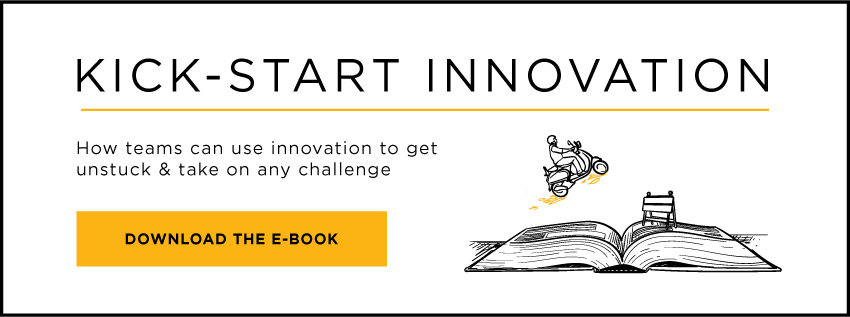One of the biggest challenges companies struggle with in adopting design thinking, is getting employees to use it outside of the training space. We’ve seen many teams flourish in design thinking workshops. They brainstorm hundreds of ideas, learn to ask brilliant questions and build prototypes that could become the next big solution for their industries.
But then they go back to work, and after a few days of buzz about how these new tools are going to change the way they do their jobs, work gets busy and they fall back into old patterns. Within a month or two, it’s business as usual and all that valuable training gets forgotten.
So how do you avoid this pattern?
The first step is figuring out what in the workplace is preventing design thinking from being adopted. The likely cause is reverting to a habit of rushing through the process, or skipping steps, to get to the end deliverable.
Other times people just don’t know where to start, says Luke Brodie, a master facilitator with ExperiencePoint. “They aren't sure what types of challenges lend themselves to being tackled using design thinking, which can result in these tools being over- or underused.”
The existing corporate culture also frequently gets in the way, says ExperiencePoint master facilitator Keith LaPlante. “If they return to a setting that is not prepared to embrace a new way of tackling challenges then the odds of them applying what they've learned are dramatically reduced.”
Fortunately all of these obstacles can be overcome — or avoided altogether — if companies take a holistic approach to design thinking. “Most participants are very enthusiastic about the learning when they leave a workshop and just need a little nudge from the boss to say, “Hey, we think this is important and we really want to leverage what you've learned,” LaPlante says.
Here a four ways that leaders can provide that nudge so design thinking processes can take root.
-
Help people identify the right places to apply design thinking. Not every problem is appropriate for a full design thinking approach and employees can be wary of where to apply these new skills. To find that perfect fit, Brodie suggests that managers meet with teams after the workshop to identify challenges that are complex, meaningful, and human-centered, then provide space for them to try any of the appropriate design thinking habits to solve them. “People can start earning quick wins that translate into stories that get shared around the organization,” he says. “These stories serve to encourage others to also start applying what they've learned and the enthusiasm will grow.”
-
Encourage trainees to find a kindred spirit. “Often the ‘tyranny of the urgent’ takes over when people leave that special moment of learning,” says facilitator Kimberly Douglas. To avoid losing what they learned to the daily grind of getting work done, she urges all of her trainees to find one or two other people they bonded with in the workshop, to be each other’s “accountability partners.” “They can push each other to put what they learned into practice to keep the momentum going.”
-
Ask people to teach another team about design thinking. Managers should let employees know that they will be invited to lead a discussion or mini training session about design thinking after the workshop. “There is no better way to embed your learning than to teach it to someone else,” LaPlante says. “And there is no better way to encourage its use than to make it a priority for everyone to understand and apply.”
-
Start with small, focused design thinking tasks. “A lot of people can feel overwhelmed by the pace of the learning when design thinking is brand new,” Douglas says. By encouraging trainees to use design thinking on small tasks within the core team, like facilitating a brainstorming session, or participating in a “how might we?” conversation, it can help them get comfortable with the processes, and prove to themselves and others that it can work. A good first brainstorming topic is “how might we engage our remote teams in a more meaningful way?” Douglas says. “Working on remote teams is one of the barriers that many trainees say gets in the way of implementing what they learned.” Tackling that challenge in a brainstorming session allows them to practice their new skills while overcoming an obstacle to using design thinking more often.
Remember, a design thinking workshop is just the first step to embracing a new way of problem-solving and design iteration, but it can’t drive transformation on its own. Business leaders need to create an environment where people aspire to be creative, and are given the resources, language and encouragement to use design thinking appropriately. When managers adopt these small solutions, they are more likely to see that training investment pay off.
Learn how to enable innovation skill-building at scale or download our free ebook Kickstart Innovation: A Guide for Organizations.
